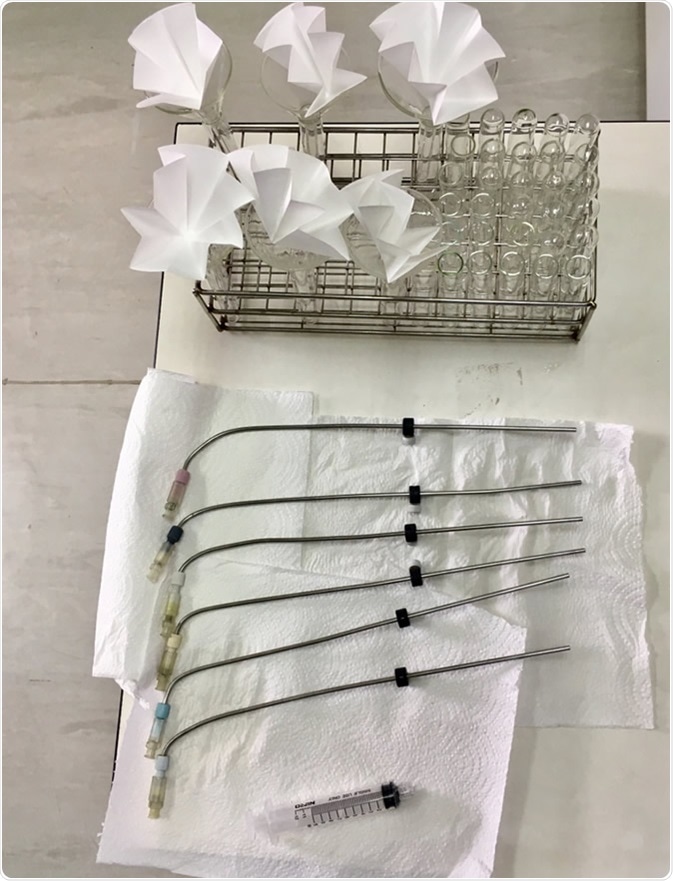Drug absorption is a pharmacokinetic parameter that refers to the way a drug is absorbed from a pharmaceutical formulation into the bloodstream.

Image Credit: By NOOMEANG / Shutterstock
Several factors can affect the absorption of a drug into the body. These include:
- physicochemical properties (e.g. solubility)
- drug formulation (e.g. tablets, capsules, solutions)
- the route of administration (e.g. oral, buccal, sublingual, rectal, parenteral, topical, or inhaled)
- the rate of gastric emptying
The main pharmacokinetic parameters for absorption include:
- Absorption rate constant: absorption rate / amount of drug remaining to be absorbed
- Bioavailability: amount of drug absorbed / drug dose
A drug must be solubilized in order to cross the semipermeable cell membranes to reach the systemic circulation. These biological barriers exist to selectively allow or inhibit the passage of native and foreign particles through them.
Absorption Type: Passive Diffusion
Passive diffusion involves the crossing of a pharmaceutical substance across a cell membrane from an area of high drug concentration, such as in the gastrointestinal tract, to an area of low drug concentration, such as in the blood.
This is a passive process that does not require energy, and the rate of diffusion is directly proportional to the concentration gradient. Other factors influencing passive diffusion include:
- the physicochemical properties of the drug, such as its:
- lipid solubility
- molecular size
- degree of ionization
- the absorptive surface area available to the drug.
In general, lipid-soluble drugs, and drugs composed of smaller molecules, cross the cell membrane more easily and are more likely to be absorbed by passive diffusion.
As most drugs are weak acids or bases, they exist in the form of an equilibrium between the ionized and un-ionized form in an aqueous environment, such as the gastrointestinal tract. The un-ionized form usually diffuses across the cell membrane more readily as it is more lipophilic. The ionized form, on the other hand, exhibits high electrical resistance and is less likely to diffuse across the membrane. The ratio of the un-ionized form depends on the environmental pH and the acid dissociation constant (pKa).

Immediate-release products allow drugs to dissolve with no delay or prolonging dissolution or absorption of the drug. - Image Credit: PNOIARSA / Shutterstock
Absorption Type: Facilitated Passive Diffusion
This refers to the passage of certain drugs across cell membranes according to the concentration gradient, but in association with specific substrate molecules which attach the drug molecule and diffuse across the membrane. This does not require energy.
Absorption Type: Active Transport
Active transport requires energy to facilitate the transport of drug molecules against a concentration gradient, which usually occurs at specific sites in the small intestine.
The majority of drugs that are absorbed via active transport share a similar structure with endogenous substances such as ions, vitamins, sugars and amino acids.
Absorption Type: Pinocytosis
Pinocytosis involves absorption of fluid or particles following their encapsulation by a cell. The membrane of the cells closes in around the pharmacological substance and fuses to form a complete vesicle, which later detaches and moves into the inside of the cell. This process also requires energy to occur.
Standard and Controlled Release Oral Administration
When a drug is taken orally, it must be able to survive the low pH and presence of potentially degrading enzymes in the gastrointestinal tract before it can be absorbed into the bloodstream. Some peptide drugs such as insulin cannot be given orally for this reason.
There are some drug formulations that manipulate the properties of the drug to control the process of absorption. These are referred to as controlled-release medications. These changes limit the degree of fluctuation of the drug concentration, so that the rate of absorption is slowed down and extended over a longer period of time.
Other Types of Administration (Non-Oral)
Drugs administered via intravenous (IV) injection or infusion do not need to be absorbed, as they are delivered directly into the bloodstream. However, there are several other types of non-oral administration routes that must be absorbed through cell membranes to reach the systemic circulation. These include buccal, sublingual, intramuscular, subcutaneous, rectal, topical, transdermal and inhaled.
Pharmacokinetics Drug Absorption Video
Pharmacokinetics 2 - Absorption
References
Further Reading